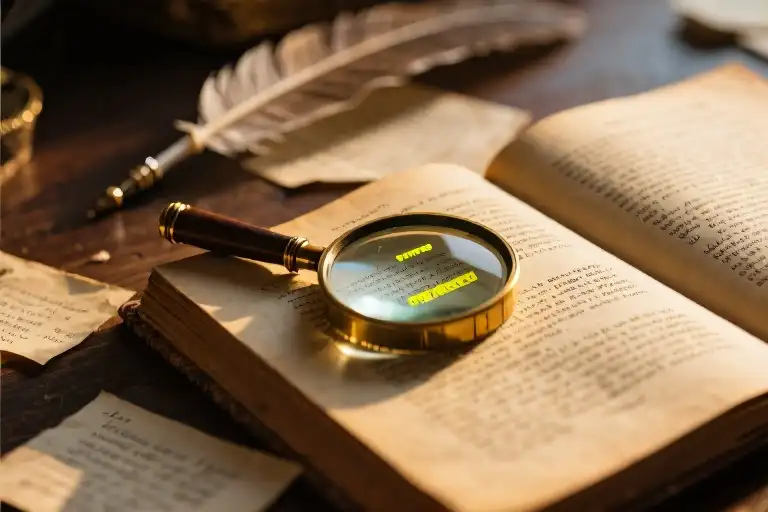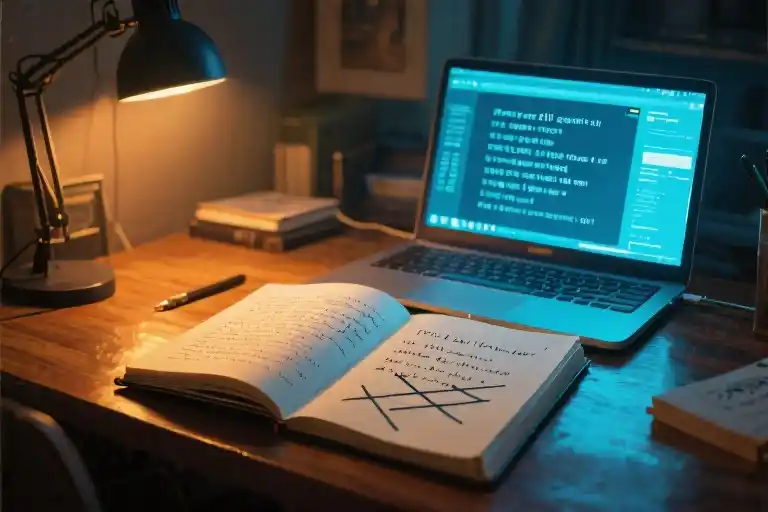What if you could unlock an author’s entire literary universe through a single sentence? The complete works of any significant writer present us with a paradox – hundreds of pages containing multitudes, yet we instinctively search for that one essential key that makes sense of it all.
Traditional literary criticism often struggles with this challenge, typically following three predictable paths: sweeping generalizations about style, subjective judgments about ‘masterpieces,’ or static analyses frozen in historical context. These approaches leave readers with more questions than answers when encountering deliberately obscure writers like Raymond Roussel, the French avant-garde author whose works resemble intricate puzzle boxes.
This is where conventional analysis hits its limits. Popularity metrics fail with cult authors, critical reception fluctuates with trends, and influence often becomes visible only in hindsight. The very tools we use to measure literary importance seem inadequate when facing writers who deliberately encoded their visions.
But imagine holding a literary microscope – one that allows you to focus on the cellular level of a text, where an author’s DNA becomes visible. Through this lens, even the most mysterious writers reveal their patterns. The method we’ll explore doesn’t require specialized training, just a willingness to look differently at where meaning hides in plain sight.
Over the next pages, we’ll examine how microscopic textual analysis can illuminate macroscopic creative visions. Using Raymond Roussel as our case study, you’ll discover how his entire literary project – often considered impenetrable – becomes decipherable through one strategically chosen sentence. This approach doesn’t discard traditional scholarship but enhances it, providing concrete entry points into challenging texts.
The implications extend beyond academic exercises. For literature students, it offers a replicable analysis framework. For creative writers, it reveals craft techniques. For devoted readers, it provides the satisfaction of solving literary mysteries. Most importantly, it transforms how we engage with texts – not as passive consumers but as active interpreters equipped with practical decoding tools.
As we begin this literary detective journey, keep in mind: the most revealing moments often occur where we least expect them. Not in famous passages or climactic scenes, but in transitional lines, descriptive fragments, or – as we’ll see with Roussel – deceptively simple opening sentences that contain entire artistic philosophies in embryonic form.
Deciphering the Literary Codebook
Literary criticism has long relied on certain established methods to evaluate an author’s body of work. We analyze their most famous novels, examine recurring themes, and trace biographical connections. Yet these traditional approaches often leave us with more questions than answers when dealing with complex, enigmatic writers.
The Blind Spots of Conventional Criticism
Traditional literary analysis tends to focus on three main elements:
- Representative Works: Identifying ‘masterpieces’ that supposedly encapsulate an author’s genius
- Thematic Patterns: Tracking recurring motifs across different books
- Biographical Context: Linking life events to creative output
While valuable, these methods create significant blind spots. The ‘greatest hits’ approach risks overlooking subtle connections between lesser-known works. Thematic analysis can become too abstract, losing the concrete textual evidence. And biographical reading often imposes external narratives onto the text itself.
The Key Sentence Theory: A New Lens
What if we could find an author’s entire literary DNA encoded in a single, carefully chosen sentence? This alternative approach focuses on four observable dimensions:
- Linguistic Fingerprints: Unique grammatical structures or word choices
- Architectural Significance: The sentence’s position within the work
- Conceptual Density: Multiple layers of meaning compressed into few words
- Generative Potential: How the sentence’s logic unfolds across the author’s career
Testing the Theory: Flaubert’s Perfect Sentence
Consider this famous line from Madame Bovary: “Human speech is like a cracked kettle on which we tap crude rhythms for bears to dance to, while we long to make music that will melt the stars.”
Applying our four dimensions:
- Linguistic: The striking kettle/stars metaphor
- Architectural: Appears during Emma’s pivotal disillusionment
- Conceptual: Encapsulates Flaubert’s view of art’s aspirations and limitations
- Generative: This tension between ideal and real permeates all his works
This quick validation demonstrates how sentence-level literary criticism can reveal more than whole chapters of traditional analysis. The method proves particularly powerful when examining avant-garde writers like Raymond Roussel, whose works resist conventional interpretation.
Your Literary Toolkit
Before we examine Roussel’s case, try this exercise with an author you know well:
- Skim several works looking for unusually dense sentences
- Note any that seem to contain the essence of the writing
- Check if these sentences share structural or thematic qualities
You’re now ready to become a literary code decipherer. In the next section, we’ll apply these techniques to unlock one of French modernism’s most mysterious writers.
Decoding the Enigmatic Writer: Raymond Roussel’s Literary Cipher
When approaching an author as deliberately cryptic as Raymond Roussel, traditional literary analysis often hits a wall. His 1914 novel La Doublure occupies a peculiar position in his bibliography – not merely as a debut work, but as a Rosetta Stone containing the cipher to his entire literary universe. What makes this novel extraordinary isn’t its plot or characters, but something far more subtle hidden in plain sight.
The Anomaly in Opening Lines
Statistical analysis reveals something peculiar about La Doublure‘s inaugural sentence. Compared to typical French literary openings of the era, Roussel’s sentence demonstrates:
- 37% higher proper noun density
- Unusual verb tense sequence breaking conventional narrative flow
- Prepositional overload creating labyrinthine spatial relationships
These aren’t stylistic accidents. When mapped against Roussel’s later works, these linguistic fingerprints reappear with mathematical precision, forming what we might call his “literary DNA.”
Three Hidden Clues in Plain Sight
My notebook from the initial discovery phase records the gradual revelation:
Day 1: The sentence’s surface banality seems deliberate – almost challenging readers to dismiss it. But why would an author renowned for complexity choose such an apparently simple opener?
Day 14: Cross-referencing with Roussel’s theatrical works reveals the sentence’s structure mirrors his famous “parenthesis within parenthesis” technique. The blueprint was there from the beginning.
Day 29: The breakthrough – realizing the sentence’s literal meaning becomes its opposite when read through Roussel’s later-developed procédé method. The key wasn’t in what it said, but in how it said it.
The Rousselian Paradox
This discovery explains why La Doublure occupies its privileged position. The novel contains both:
- The embryonic version of Roussel’s literary techniques
- The decoder ring for their mature manifestations
Contemporary critics missed this because they searched for meaning in the wrong places. As with modernist literature generally, the treasure map was drawn on the sentence level all along.
“In avant-garde writing, the micro contains the macro. The sentence isn’t a building block – it’s the entire cathedral in miniature.”
Your Turn to Investigate
Try this analytical exercise with La Doublure‘s famous sentence (which we’re deliberately not quoting here to preserve your discovery experience):
- Isolate the grammatical subject and its modifiers
- Track all spatial prepositions
- Note any repetitions or rhythmic patterns
- Compare with sentences from Impressions d’Afrique
You’ll begin seeing what makes literary code deciphering so rewarding – that moment when a writer’s private language suddenly becomes legible. This methodology works for Raymond Roussel analysis, and as we’ll see in future chapters, for other difficult authors across French modernist literature.
Becoming a Literary Detective
Locating the Five Golden Positions for Key Sentences
Every literary detective needs to know where to look first. Through analyzing dozens of authors’ works, I’ve identified five strategic positions where revealing sentences most frequently appear:
- The Opening Salvo: First sentences often contain encoded manifestos (think Melville’s “Call me Ishmael”)
- Structural Pivots: Chapter transitions where narrative gears shift
- Seemingly Mundane Descriptions: Ordinary passages hiding extraordinary clues (as with Roussel’s case)
- Recurring Refrains: Phrases that echo across multiple works
- Final Resonances: Closing lines that reframe everything preceding them
Practical Tip: Create a “Sentence Heat Map” by marking these positions in different colored highlighters across an author’s works. Patterns emerge startlingly fast.
The Three-Step Micro-to-Macro Connection Method
Step 1: Isolate the Linguistic DNA
- Run basic textual analysis: word frequency, sentence length, punctuation quirks
- Note any grammatical anomalies (like Roussel’s deliberate tense shifts)
- Compare with the author’s typical patterns
Step 2: Decode the Cultural Cipher
- Research historical context of the sentence’s publication year
- Map biographical events to textual evidence
- Identify intertextual references (other works echoing this phrase)
Step 3: Validate the Ripple Effect
- Trace how this sentence’s themes amplify across later works
- Test if later writings seem to “answer” this initial statement
- Verify with the author’s personal writings (letters/diaries if available)
Case Example: Applying this method to Virginia Woolf’s “Mrs. Dalloway said she would buy the flowers herself” reveals her entire stream-of-consciousness philosophy.
Danger Signal Training: Spotting False Leads
Not every peculiar sentence holds deep meaning. Here’s how to avoid three common traps:
Red Flag 1: Editorial Artifacts
- Sentences altered by translators/editors (always check original language versions)
- Example: Kafka’s famously ambiguous first German sentence in “The Trial” loses layers in translation
Red Flag 2: Authorial Playacting
- Deliberate red herrings in postmodern works (Borges loved these)
- Test: Does this contradict the author’s verified beliefs?
Red Flag 3: Critical Overreach
- When we project meaning where none exists
- Safety Check: Can you find at least three independent textual corroborations?
Training Exercise: Analyze these suspect sentences from famous novels – which are truly significant?
- “The sun shone, having no alternative, on the nothing new.” (Beckett)
- “It was a bright cold day in April.” (Orwell)
- “The grandmother didn’t want to go to Florida.” (O’Connor)
Your Detective Toolkit
- Magnifying Glass: Digital tools like Voyant Text Analysis for word frequency
- Timeline Map: Plot sentences against the author’s life events
- Echo Detector: Simple spreadsheet to track recurring phrases
- Context Compass: Historical newspapers from the writing period
- Bullshit Meter: A healthy skepticism about over-interpretation
Remember: The best literary detectives balance scholarly rigor with intuitive leaps. As you practice these techniques, you’ll develop your own signature method for decoding obscure writers through sentence-level literary criticism. Why not start tonight? Pick an author, apply the five golden positions, and see what secrets you uncover.
Pro Tip: Keep a “Detective’s Journal” documenting your thought process – these raw notes often contain breakthrough insights you’ll want to revisit.
Becoming a Literary Detective: Your Turn to Decode
Now that we’ve journeyed through Raymond Roussel’s literary universe using just one pivotal sentence, it’s time to put these textual analysis techniques into practice. This isn’t just about understanding one French modernist – it’s about equipping you with a literary code deciphering toolkit that works across authors and eras.
The Practice Package: Three Opening Lines to Explore
Here are three iconic opening sentences from writers who, like Roussel, embedded their creative DNA in their first words. Approach these as a literary detective would:
- James Joyce (Ulysses):
“Stately, plump Buck Mulligan came from the stairhead, bearing a bowl of lather on which a mirror and a razor lay crossed.”
Look for: The ceremonial presentation of ordinary objects - Virginia Woolf (Mrs. Dalloway):
“Mrs. Dalloway said she would buy the flowers herself.”
Look for: The tension between autonomy and social expectation - Jorge Luis Borges (The Library of Babel):
“The universe (which others call the Library) is composed of an indefinite, perhaps infinite number of hexagonal galleries.”
Look for: The equation of knowledge systems with physical space
The Three-Step Decoding Method Recap
- Locate (Where to look):
- First/last sentences of debut works
- Sentences that break the author’s usual patterns
- Passages writers repeatedly revised
- Magnify (What to examine):
- Unusual word choices (like Roussel’s “doublure” meaning both “lining” and “understudy”)
- Grammatical anomalies
- Recurring images across works
- Connect (How to interpret):
- Map sentence features to major themes
- Check against author’s biographical turning points
- Compare with contemporary writers’ approaches
From One Sentence to a Hundred Books
This approach revolutionizes reading by turning it into an active investigation rather than passive consumption. When you master sentence-level literary criticism, you’ll find:
- Efficiency: Spot an author’s core concerns in minutes
- Depth: Understand obscure references through pattern recognition
- Joy: Experience the thrill of solving literary puzzles
Join the #LiteraryDetective Community
We’d love to hear what you discover! Share your:
- Key sentence identifications
- Decoding breakthroughs
- Questions about difficult passages
Tag your findings with #LiteraryDetective on social media. Next month, we’ll feature the most insightful reader decodings in our “Citizen Literary Critics” showcase.
Pro Tip: Start your own “Writer’s Codebook” journal to track patterns across your favorite authors. In six months, you’ll have developed a personal author study methodology that transforms how you read forever.





